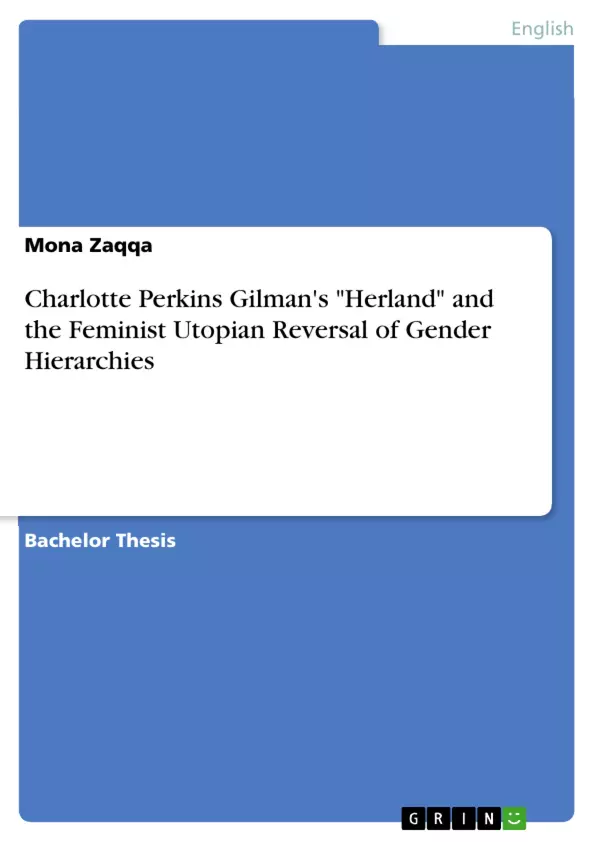This paper examines how Gilman contrasts her imagined utopia with reality, and thereby creates a reversal of gender hierarchies. It elaborates primarily on the topics of education, labour distribution and motherhood – which will be consecutively investigated with regard to their utopian representation in Gilman's "Herland", as well as the author's theoretical work regarding each subject.
The reformist mindset that followed the rapid industrialization and urbanization of the US-economy during the turn of the 20th century led to a re-emergence of utopian literature (Bartkowski 7). Following the success of Edward Bellamy's Looking Backward 2000-1887 (1888), utopian novels gained in importance and popularity as a medium for discussing issues resulting from the radical changes occurring at the time. Not only did they reflect the country's prevalent dissatisfaction with deficient political, economic and social conditions, but they also provided a platform for writers to explore alternative structures beyond the limits of reality. For feminist writers, the utopia enabled them to envision emancipation from patriarchal structures and challenge prevailing gender hierarchies. Charlotte Perkins Gilman is ranked among the most influential voices of the feminist reform movement of the Fin de Siècle, and is best known for her utopian novel "Herland" (1915). She herein thematizes the issue of gender inequality through an isolated and thriving all-female society and pictures the possibilities that would arise for women without the limitations of patriarchy.
Table of Contents
- Introduction
- The New Woman and the Feminist Utopia
- Contesting Gender Hierarchies in Herland
- Social Constructs of Gender
- Power-assertion
- Cultural Contribution
- Courting and Appearance
- Labor Distribution
- Education
- Motherhood
- Social Constructs of Gender
- Conclusion
- Works Cited
Objectives and Key Themes
This thesis explores Charlotte Perkins Gilman's utopian novel Herland (1915) and its depiction of a feminist utopia. The primary objective is to analyze how Gilman contrasts her imagined utopia with reality and reverses traditional gender hierarchies. This examination includes exploring the social constructs of gender in Herland, the novel's critique of patriarchal structures, and its presentation of alternative possibilities for economic and social structures.
- The feminist utopia as a means of challenging patriarchal structures and envisioning gender equality.
- The reversal of gender hierarchies in Herland through the depiction of an all-female society.
- The novel's critique of traditional gender roles and the limitations they impose on women.
- The exploration of alternative possibilities for labor distribution, education, and motherhood in a feminist utopia.
- The relationship between Gilman's personal experiences and her fictional work, particularly in relation to women's mental health and the pressures of domesticity.
Chapter Summaries
The introduction sets the context for Gilman's novel, highlighting the rise of utopian literature in the early 20th century and its connection to the feminist reform movement. It also introduces Gilman's personal experiences and how they informed her writing, focusing on her critique of patriarchal structures and her advocacy for women's equality.
The second chapter delves into the "New Woman" ideal and its influence on feminist utopian writings. It examines how Gilman's novel contributes to this trend by depicting an all-female society free from the constraints of patriarchy. This chapter explores the social and cultural changes of the late 19th and early 20th centuries and how they contributed to the emergence of feminist thought and activism.
Chapter three analyzes the social constructs of gender in Herland, contrasting them with traditional patriarchal expectations. It examines the novel's portrayal of gender roles, power dynamics, and the distribution of labor in the all-female society. This chapter delves into Gilman's critiques of power-assertion, cultural contributions, courting and appearance, and the traditional roles assigned to women in a patriarchal society.
Keywords
The key concepts explored in this thesis include: feminist utopia, gender hierarchies, patriarchal structures, social constructs of gender, labor distribution, education, motherhood, Herland, Charlotte Perkins Gilman, New Woman, and feminist reform movement. These keywords highlight the central themes and research focuses of the work, offering a comprehensive understanding of its scope and objectives.
- Quote paper
- Mona Zaqqa (Author), 2019, Charlotte Perkins Gilman's "Herland" and the Feminist Utopian Reversal of Gender Hierarchies, Munich, GRIN Verlag, https://www.grin.com/document/1147648



